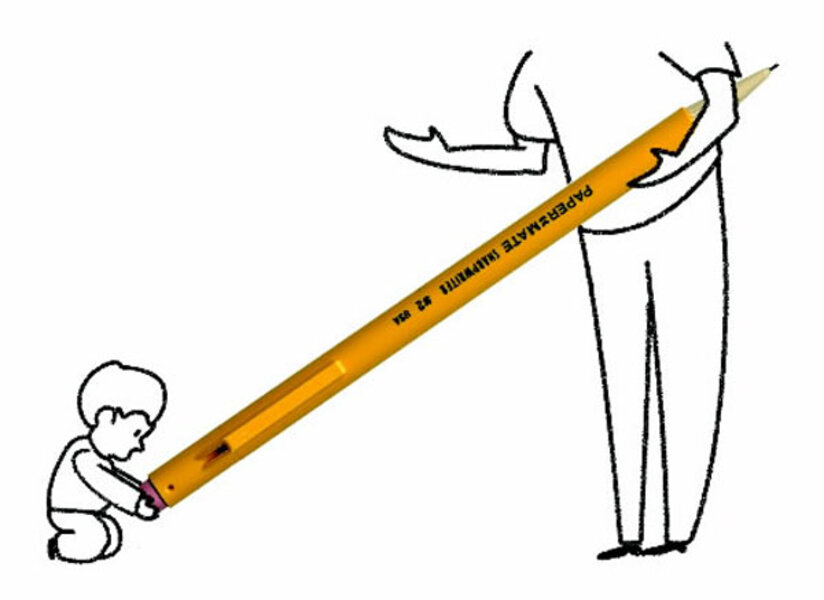Media literacy for preschoolers requires active parent viewing
Loading...
In today’s media-saturated world, raising media literate children is an increasingly important goal. Our kids need No. 1, to understand how the media work; No.2, to be able to think critically about media content; and No. 3, learn how to create their own media texts – empowering them not just to consume, but also create.
In my previous blog explored my family’s approach to teaching our four-year-old son how the media work – particularly, how commercials work. From an early age, he learned my mantra: “Commercials try to sell us things we don’t need.” This simple concept helps him understand that commercials aren’t neutral or factual. They have an agenda: persuasion. And kids have such an innate sense of justice that the idea of being “tricked” really rankles them!
Although my son will often complain about commercials trying to sell him things he doesn’t need, some days, he has a little fun at my expense. He’ll look at me with a wicked gleam in his eye, a smile playing on his lips, and say, “Mommy. I LIKE commercials.” The little tease!
This always makes me smile, at least inwardly: If he has figured out that he can tease me about liking commercials, he has also figured out what my values are. And knowing what we value as a family is an important part of thinking critically about media content.
A couple of strategies have worked well in helping my four year old develop the ability to think critically about what he sees on screen, which is a fundamental part of being media literate. First, I make sure that we watch things together, and that while we’re viewing, we talk about what’s on screen in ways that draw upon our family’s values.
Second, I find opportunities to talk with him about his favorite shows at other times – like when we’re driving in the car, or having dinner, or chatting before bedtime – when we can have broader conversations, e.g., comparing different movies he likes.
By viewing media together, parents can help their children become media literate. This means that whenever possible, I watch programs with my son, so that I’m present to see and hear his reactions.
But viewing together is not enough; active viewing is key. This means I talk with my son about what we are seeing. I talk back to the screen, share my ideas and concerns with my son, and respond to anything he says, too.
We wind up talking about characters’ behaviors a lot. Lots of kids’ programs focus on bad behaviors. Academic studies show that even prosocial children’s media, like the kind found on PBS that are meant to teach lessons about good behavior, spend way too much time modeling bad behavior. The result: little kids often don’t pick up on the resolution or good behavior that such programs mean to encourage. The exciting and interesting bad behaviors get all the attention.
Because I’m aware of this problem, when my son and I are watching movies or television programs together, I’m quick to point out on-screen behaviors that I don’t like – in a gentle way, of course. I might say, “Thomas should tell Sir Topham Hat the truth!” or “Gee, I don’t like the way the Witch is talking to Rapunzel right now – that’s cruel,” or “Uh-oh, Spike is being really greedy! That’s not nice.”
In the interest of positive reinforcement, I’ll point out good behaviors, too. “That was really kind of Kanta to let the girls take his umbrella,” or “It was so clever how Word Girl figured that out,” or “Rarity is so generous with her friends.”
Sometimes, I’ll phrase my commentary as questions: “Do you think that’s a good idea?” or “What do you think of that?”
What’s great is that the older he gets, the more often he’ll turn to me and offer the kinds of commentary that I model for him. For example, we recently watched "Beauty and the Beast" together for the first time; he’d been asking about it for a while. ”The Beast shouldn’t yell like that,” he told me. “It’s naughty.” Then, later, when Belle appeared in her gold dress for the ballroom scene: “Hey, where did her blue dress go that I like??” (blue is his favorite color.) Whatever his comments are, I like to hear them – and I make sure to give him an answer so he knows I’m listening.
Even though my son is only four, I’ve had some conversations with him about topics or behaviors that are shown across more than one program and movie. Such conversations need to take place while the television is off, so I’ve found it important to pay attention to his interests and his reactions while we’re viewing things together, to gauge what he might like to talk about later.
For example, my son has been interested in the concept of “thieves” since he was about two-and-a-half years old. One day, our family were enjoying a picnic on a park bench in Salem, Mass., when a sneaky seagull stole his sandwich! It just crept up behind us and grabbed it through the slats in the bench. To say we were caught off guard is an understatement.
Our little guy was really upset about losing his sandwich this way, so we encouraged him to shoo the nearby seagulls away by shouting, “Go away, thieves!” He seemed a bit empowered by his ability to fight back.
Now, anytime we are at the beach or another location where seagulls approach, he is vigilant about shooing them away, saying, “You can’t have our food, thieves!” He’s even noticed seagulls creeping up on other families and seems to have made it his personal mission to try to scare encroaching seagulls away. He doesn’t like thieves.
About a year ago, he had an experience with a real thief when my iPhone was stolen while we were running errands in the mall. I wound up spending a couple of hours in the mall’s Apple store, tracking the phone’s whereabouts on their computers (“Find my iPhone” is an amazing application) and giving a police report to an officer who came to meet me. We were actually able to recover it that same night – but that is a story for another day!
In the midst of all the excitement about mommy’s phone being stolen, my son was amazed to learn that people could be thieves, too – not just seagulls.
Oh.
Yes, we said; some people are thieves!
Then came the inevitable, perplexed question: “Why?”
Well, because sometimes, people make bad decisions.
So, between the seagulls and the iPhone theft, thieves have been an occasionally recurring topic of conversation. (Key questions he’s asked have included: “Do thieves live in houses?” and “Do thieves have teeth?”)
And guess what? After becoming enamored of the Disney films "Tangled" and "Aladdin," he realized that Flynn and Aladdin are thieves. Thieves! Uh-oh. He had a hard time making sense of this, since both are really likable characters, and he feels very keenly that stealing is wrong.
So we’ve talked a lot about why Flynn and Aladdin are thieves, and the differences between the two characters. Flynn seems to steal because he’s greedy and thinks it’s fun; in his verse of the “I’ve Got A Dream” song, he sings that his only dream is to be “surrounded by enormous piles of money.” In contrast, Aladdin is a boy without parents who steals food because otherwise, he won’t eat. And he’s not greedy, either: in an early scene in the film, he gives his stolen bread away to littler kids who are also hungry, showing that he is a kind person.
As a result of these conversations, when we’re watching "Tangled," he will sometimes offer his own running commentary. He’ll say things to me like, “Flynn shouldn’t be a thief! That’s too naughty,” or ”Poor Aladdin! He is a thief because he doesn’t have any mommy or daddy or food. He doesn’t want to be a thief.”
In my opinion, being able to identify differences between on-screen characters and their motivations is a form of age-appropriate media literacy. It’s the result of talking and thinking critically about how people are represented, and why characters are shown doing the things they do. I’m glad that my child has a basic understanding that depictions of bad behaviors don’t make those bad behaviors okay, even when the characters engaged in them are fun and exciting.
In other words, media literacy can be developed in simple, age appropriate ways, connected with real world experiences.
My hope is that these conversations are laying important groundwork for the future, making it clear that we discuss and think critically about media content in our family. Considering the content he’ll likely see later in childhood and in adolescence, I think it’s crucial to establish parent-child communication and critical thinking practices as the norm now.
The Christian Science Monitor has assembled a diverse group of the best family and parenting bloggers out there. Our contributing and guest bloggers are not employed or directed by the Monitor, and the views expressed are the bloggers' own, as is responsibility for the content of their blogs. Rebecca Hains blogs at rebeccahains.wordpress.com.






